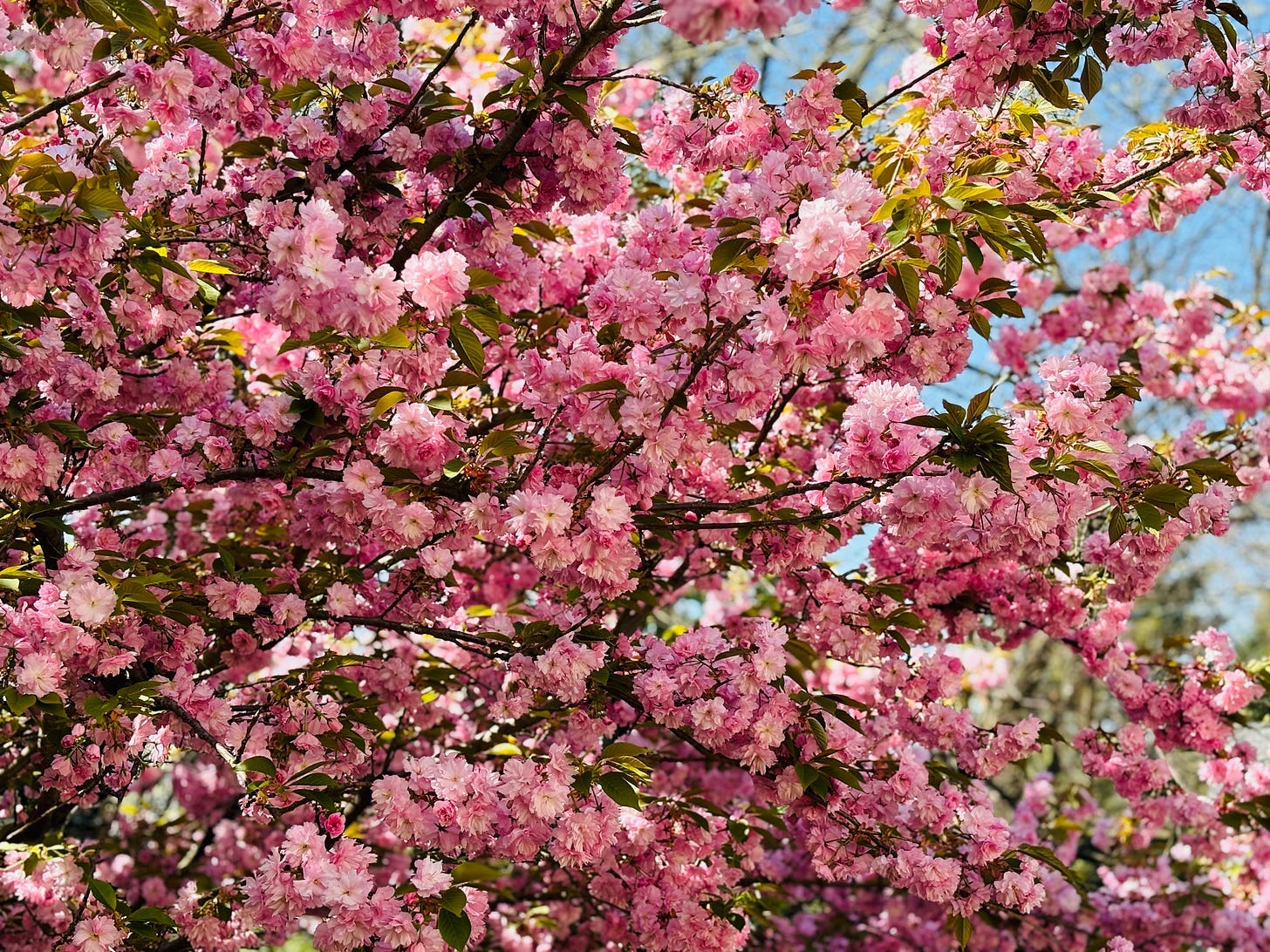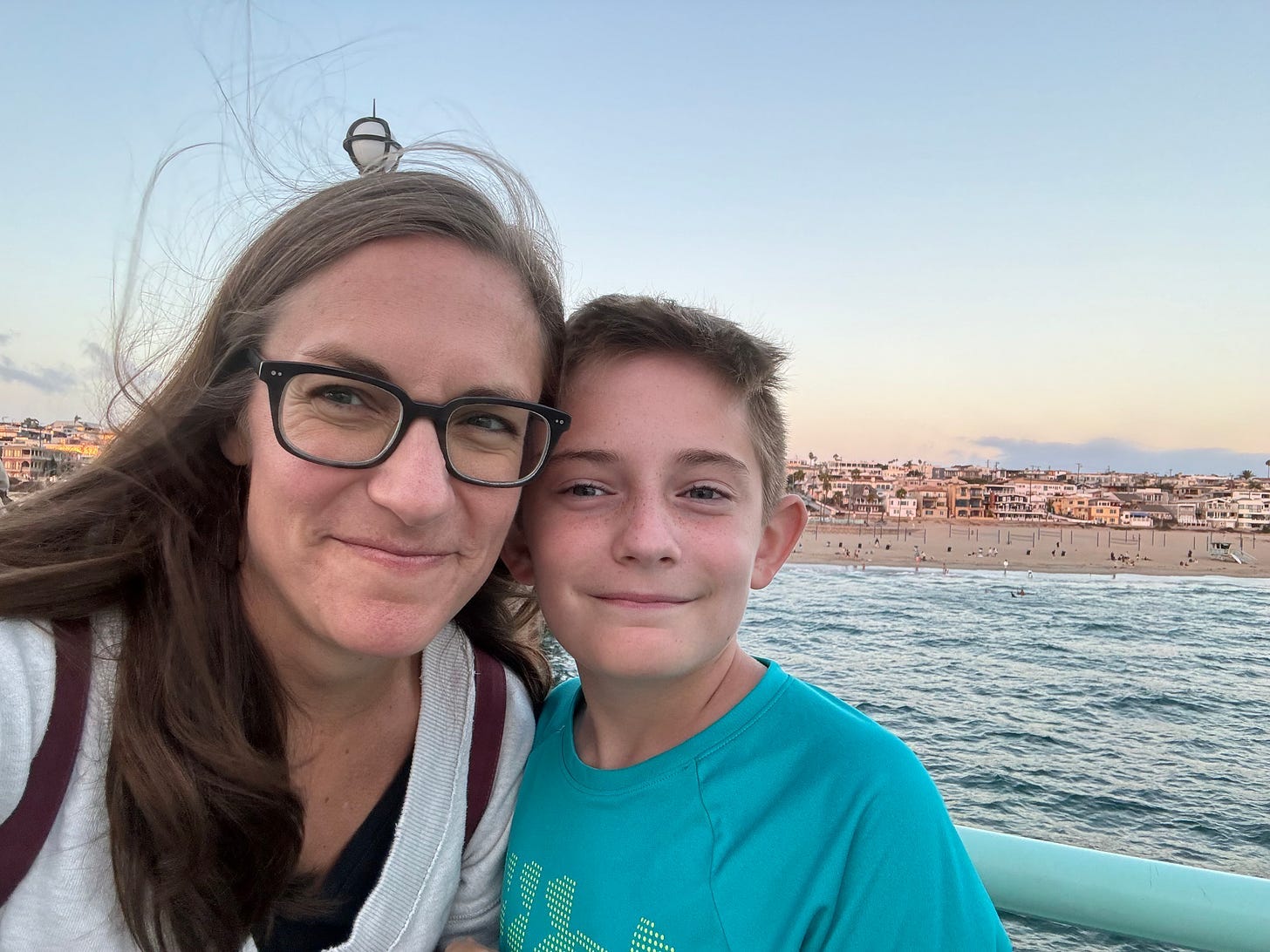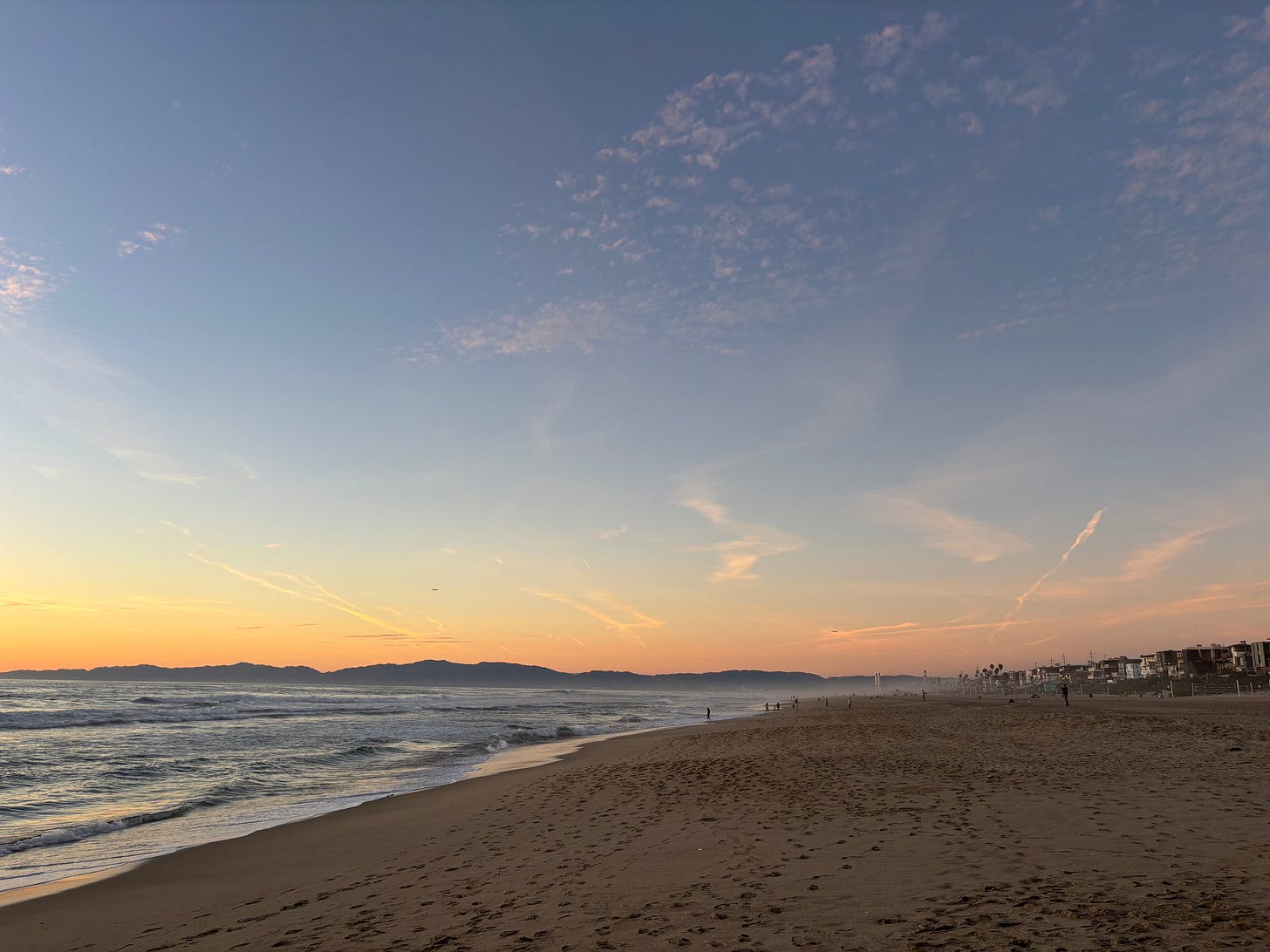On Impermanence
the seasons, those dudes dancing in rainbow tracksuits, redwoods, time, human frailty, and power
Welcome to Be Where You Are. I’m a writer & teacher exploring meditation & mindfulness & the in-between spaces that are awkward, beautiful & kind of magic. If you enjoy this newsletter, if you look forward to it in your inbox, please consider paying a few dollars a month for a paid subscription to help me keep it going. And, if you can’t pay anything, please share it with someone that you think might need it! 🩵
One of the biggest surprises for me in moving to Los Angeles is how much I’ve missed the seasons. As someone who has only lived in Pittsburgh or places further east or north, I was certain I’d love the perpetual Goldilocks weather, that I’d be bopping down the street coatless in January with a stupid grin on my face. A few Pittsburgh friends had said to me, “I could never live in Southern California; I’d miss the fall,” and I smiled and nodded and thought they were deluded. I felt so done with scraping ice crystals off the windshield and soldiering through the persistent grey.
I love living near the beach and many things about LA, but I’ve also felt dislocated from the passage of time. Disoriented. I’m trying to be where I am (like this newsletter’s name continually reminds me), but I truly didn’t realize it was December until mid-December. I’m still waiting for cool and dark and grey to shift into hibernation mode, or “wintering,” as Katherine May calls it.
All this has made me think a lot about impermanence. The seasons are one of the most visible markers of impermanence that we have in the real world around us. In the digital world, we can craft brands that are ever shiny (if vulnerable to being stolen or trolled, etc). We can live untethered from the seasons. Someone is always on vacation somewhere warm; someone is always on a snowy hike or posting a ski selfie. Those two dudes are always dancing to Celine Dion in rainbow tracksuits overlaid onto various backgrounds.
But in the real world, even in LA, things are continually changing, no matter how subtle those changes are. Back in Pittsburgh or other East Coast cities I’ve lived in, each season announced itself with dramatic fanfare. In the fall, the Japanese maple outside our kitchen window turned a vibrant crimson before shedding its leaves in October.
Winter arrived with frost on the windshield, an icy wind, a dusting of snow. Spring, with the lustrous cherry tree in our backyard blooming in April. Summer showed up with sun, sweat, longer days and of course, mosquitoes.
Now, here in LA, without ever having fall or early winter, we’re in a January that feels interminable and apocalyptic despite the buttery gold sun. It’s January and the sun is still out constantly. In fact, I just noticed my first liver spot on my face and wondered, am I really that old? (ahhh impermanence). With the fires and the inauguration and multiple ongoing international conflicts, it’s been January for what feels like months and it’s somehow still January. Hunter Harriss says in her recent post “It should simply stop being January. This must all end.” I mean, it will end eventually, right?
In my internal landscape, my anxiety has been evergreen. It ratcheted up with our move and the run-up to election season and it hasn’t fully let up since. The day after the election, I was a cocktail of anxiety and emotion which I’d worked hard to try to keep bottled up until my kids left for school. Once I was alone, I sat on the couch and opened up the Plum Village app to meditate, as I do each morning, even though I knew it would be tough. I knew I couldn’t handle just using a timer and silence; I needed another voice guiding me in the quiet to chill the eff out. I scrolled through the meditations until I landed on one called “Guided Meditation on Impermanence” by Brother Bao Tich.
I breathed and tried to follow my breath while listening to Brother Bao Tich say in a serene voice:
“Aware of my body, I breathe in.
Seeing the impermanence of my body, I breathe out.
Body, impermanent…
Aware of governments, I breathe in
Seeing the impermanence of governments, I breathe out.
Governments, impermanent.”
At first, this meditation tangibly helped me. I felt a release just remembering that this administration won’t last forever. But then, it was replaced with the realization that Supreme Court appointments are lifetime appointments. Not forever, but pretty damn lasting. And, the executive orders that prioritize corporations over our earth (“drill baby drill”) will have lasting damage. This government is impermanent, but that doesn’t mean it can’t inflict permanent damage in this lifetime for countless living beings, communities, and our earth. And now we have this new round of orders to freeze funding for programs like Meals on Wheels, The National School Lunch Program and Medicaid.
It’s easy to meditate on impermanence with the little things. The tangerine you hold in your hand, its sweet scent. The mug of tea that goes cold. The serene quiet in your house swiftly broken by your kids yelling, or your daughter typing random words into your draft (happening at this very moment).
Tangerine, impermanent.
Tea, impermanent.
Children yelling, impermanent.
It’s harder with the big things. Losing a family member. A pet. A dear friend. A home. Our aunt and uncle and cousins are one family of many who lost their beloved home in the fires here in LA. They are grappling with a loss I struggle to imagine.
Thich Nhat Hahn writes in You Are Here: Discovering The Magic of The Present Moment, “Impermanence is the very heart of life. It makes life possible. Reject impermanence, and you reject life.”1
I think of the Stagg Tree in Sequoia National Forest, which we visited in October, hugged and took pictures next to, bending our necks back to try to see where she touched the sky.
Although the Stagg Tree is constantly, imperceptibly changing—as we stood there, we watched a few ants burrowing into her bark—she’s also lasted over 3000 years. She is changing and immovable. Rooted so deeply into the earth, witnessing us as what? Maybe not so different from the ants.
Ants, impermanent.
Humans, impermanent.
Stagg Tree, impermanent.
Why do we cling so tightly to our fixed ideas of ourselves, others, the world around us even when we know all things are passing? Even after we witness the enormous strength and magnificence of the Stagg Tree? Maybe because we’re built to survive, and to survive, we need to plan and control and hoard. Our lizard brains are still strong in us and prize security and success, and our culture reinforces this all day and night. Because of habit, ease, exhaustion.
Meditating on impermanence the day after the election sitting on my couch, I felt the grip on my heart loosen. Brother Bao Tich’s words didn’t change the reality of our world, but they changed my position to it. A peace entered my heart that connected to a core memory from childhood.
Of me sitting on the soft red pew cushion of Hiland Presbyterian Church with my family, listening to my beloved minister, Reverend Hetz Marsh, and trying not to laugh at whatever joke my sister was writing on the prayer card next to me. Trying to listen, or reading my book or writing in my journal (thanks, Mom, for letting me do that), when Reverend Marsh called me “dust.”
“You are dust, and to dust you shall return," he said in his warm, engaging voice.
I am dust?
I felt something new—my own smallness. My utter finiteness.
The whole verse reads: “Man’s fate is like that of the animals; the same fate awaits them both: As one dies, so dies the other. All have the same breath; man has no advantage over the animal. Everything is meaningless. All go to the same place, all come from dust, and to dust all return.”
From a larger view, I am no more than dust and so are you. I’m still struck with a tremendous feeling of comfort in that. I don’t have to fix everything. I can’t fix everything in the time I’m here. I am dust—stardust, mind you—and I will return to dust.
In the midst of my thinking about this and jotting down notes, I scrolled Instagram (because habit, exhaustion) and came across Nina Simone’s rendition of this song, and damn, it’s hauntingly beautiful and makes me feel all the things I’m writing about here, and so I must share it in case you want to listen while you read a few more paragraphs.
All things are changing and we are finite, but I resist the idea that “everything is meaningless.” I read that line as a command to loosen our hold on the usual meanings we ascribe to things, even to our actions. We can choose how we use our short time on this earth, but we need to be able to see through outward appearances to hold things in a larger perspective, even while we labor for the work we’re called to do.
Ashes to ashes, dust to dust means no matter how old we are or how young we are, how rich or poor, how powerful or humble, we are all human. We are all mortal, we are all caught up in this mystery—no matter where we live or who we voted for or if we’re flying in a private jet or taking the city bus.
When I looked at this verse again this morning, I realized there was more to it than I remembered: “Who knows if the spirit of man goes upward and if the spirit of the animal goes down into the earth? So I saw that there is nothing better for a man than to enjoy his work, because that is his lot. For who can bring him to see what will happen after him?”
Rather than a paean to workaholism, I read this as a reminder to focus on what it is given to us to do. The people and communities and problems that we can help, dust that we are. Those we might strive to infuse with our love and humanity and hard work while we are here on this side.
I think of the Fanny Howe poem, “I Won’t Be Able to Write From the Grave”:
I WON’T BE ABLE TO WRITE FROM THE GRAVE I won't be able to write from the grave so let me tell you what I love: oil, vinegar, salt, lettuce, brown bread, butter, cheese and wine, a windy day, a fireplace, the children nearby, poems and songs, a friend sleeping in my bed- and the short northern nights. held together by friends —Fanny Howe, Selected Poems, University of California Press, 2000.
Howe makes us aware of the grave and its silence first, as a way to ground us in impermanence. Then, the speaker tells us what she loves because later, she won’t be able to do so. Against the backdrop of the grave, the things she loves are more luminous, more alive. Each simple thing she lists seems to pulse and glow, and then she thrusts us into “the short northern night. / held together by friends.”
Isn’t everything always happening against the backdrop of the grave? Even when we know it’s there, we forget or deny it. Even walking in a cemetery, we can focus on the trees, the beautiful archways, the birds gathering. But when we name impermanence as such, when we remember the seasons and its cycles, and we remember that we are part of it, we can remember that it is ok that all will change.
We cling to what we love and keep living in this difficult world, “held together by friends” and family, and hope that we can do something that matters with the time we have.
Clicking the heart to like this post is a great and free way to support this newsletter. If you read these posts and value this work, please consider a paid subscription at a few dollars a month to help me keep this growing. 🩵🩵
Be Where You Are is a newsletter about how to use writing and mindfulness to live more fully where you are. If you have ideas to share for future newsletters, you can reply to this email. You can also find me on Instagram or Facebook or find more info at my website. Thank you for reading! 🩵🩵
Hahn, Thich Nhat. You Are Here: Discovering the Magic of the Present Moment, Shambhala Publications, Boulder, 2010.











I'm grateful for all your posts and especially this one. Yes—impermanence makes everything I do both supremely important and completely nonsignificant. I can live with that.
This resonates with me so deeply right now. Thank you, Emily!